Background
Single-leader and multi-leader replication are based on the idea that a client sends a write request to one node (the leader), and the database system takes care of copying that write to the other replicas. A leader determines the order in which writes should be processed, and followers apply the leader’s writes in the same order.
Some data storage systems take a different approach, abandoning the concept of a leader and allowing any replica to directly accept writes from clients. Some of the earliest replicated data systems were leaderless, but the idea was mostly forgotten during the era of dominance of relational databases. It once again became a fashionable architecture for databases after Amazon used it for its in-house Dynamo system. Riak, Cassandra, and Voldemort are open source datastores with leaderless replication models inspired by Dynamo, so this kind of database is also known as Dynamo-style.
In some leaderless implementations, the client directly sends its writes to several replicas, while in others, a coordinator node does this on behalf of the client. However, unlike a leader database, that coordinator does not enforce a particular ordering of writes. As we shall see, this difference in design has profound consequences for the way the database is used.
Writing to the Database When a Node Is Down
Imagine you have a database with three replicas, and one of the replicas is currently unavailable—perhaps it is being rebooted to install a system update. In a leader-based configuration, if you want to continue processing writes, you may need to perform a failover.
On the other hand, in a leaderless configuration, failover does not exist. The diagram below shows what happens: the client (user 1234) sends the write to all three replicas in par‐allel, and the two available replicas accept the write but the unavailable replica misses it. Let’s say that it’s sufficient for two out of three replicas to acknowledge the write: after user 1234 has received two ok responses, we consider the write to be successful. The client simply ignores the fact that one of the replicas missed the write.
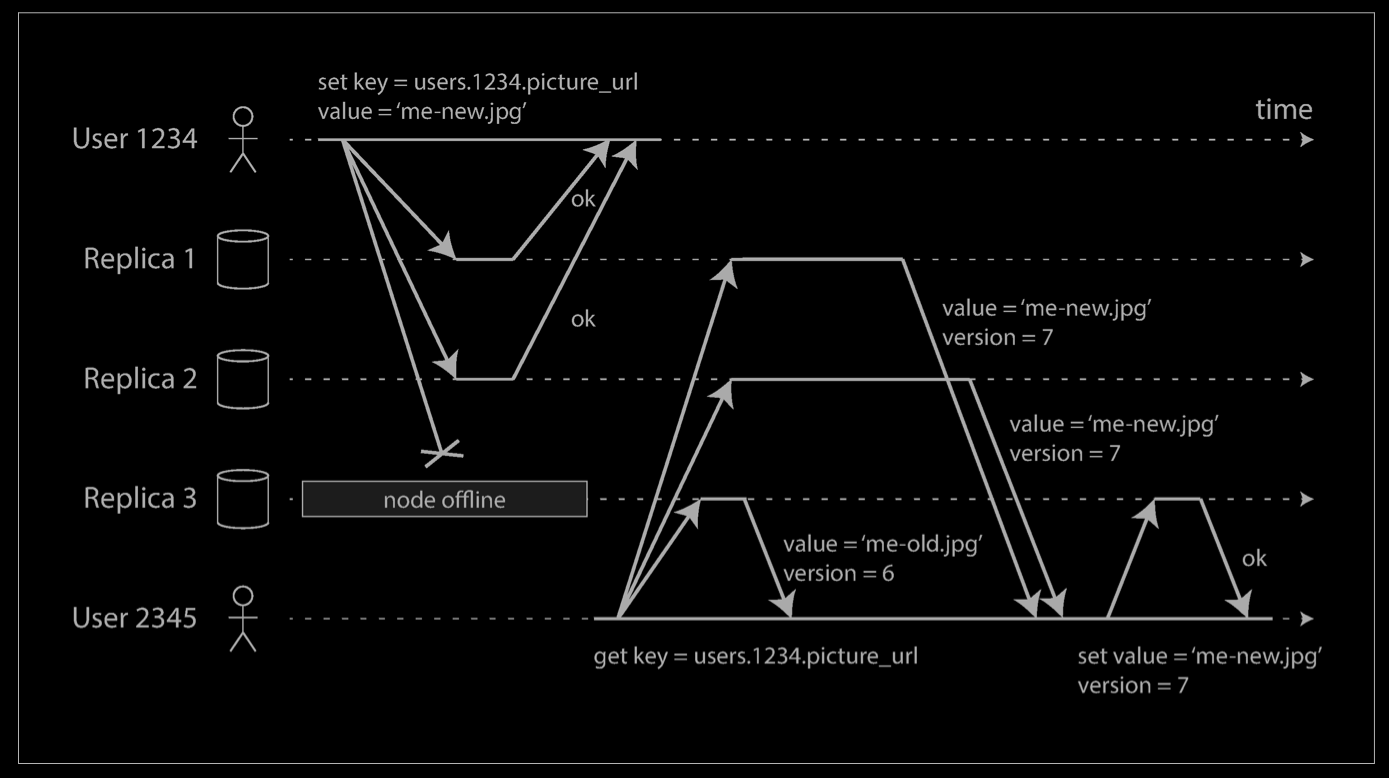
Now imagine that the unavailable node comes back online, and clients start reading from it. Any writes that happened while the node was down are missing from that node. Thus, if you read from that node, you may get stale (outdated) values as responses.
To solve that problem, when a client reads from the database, it doesn’t just send its request to one replica: read requests are also sent to several nodes in parallel. The client may get different responses from different nodes; i.e., the up-to-date value from one node and a stale value from another. Version numbers are used to determine which value is newer. Version numbers are used to determine which value is newer.
Read repair and anti-entropy**(反熵)**
The replication scheme should ensure that eventually all the data is copied to every replica. After an unavailable node comes back online, how does it catch up on the writes that it missed?
Two mechanisms are often used in Dynamo-style datastores:
Read repair
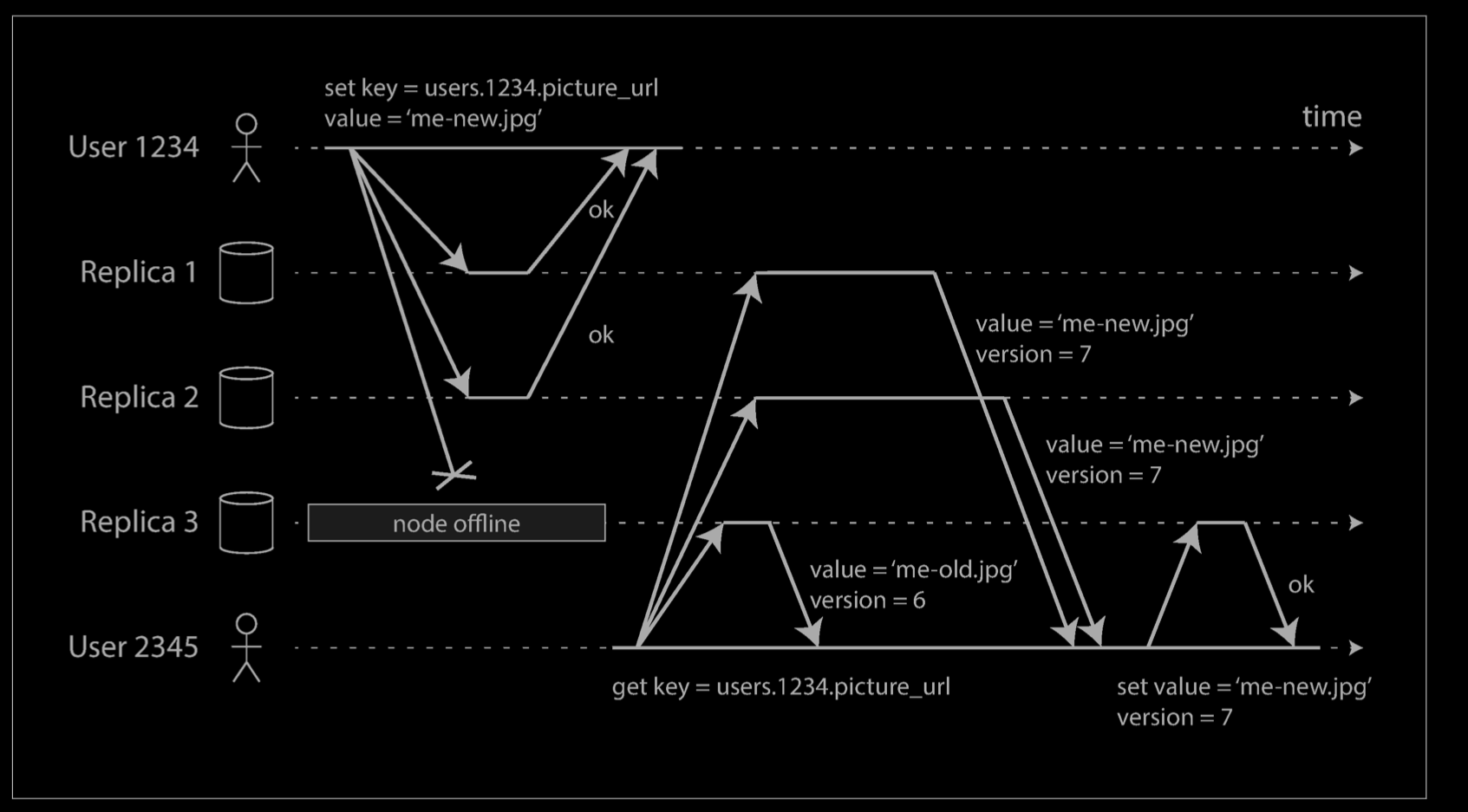
When a client makes a read from several nodes in parallel, it can detect any stale responses. For example, in the example above, user 2345 gets a version 6 value from replica 3 and a version 7 value from replicas 1 and 2. The client sees that replica 3 has a stale value and writes the newer value back to that replica. This approach works well for values that are frequently read.
Anti-entropy process
In addition, some datastores have a background process that constantly looks for differences in the data between replicas and copies any missing data from one replica to another. Unlike the replication log in leader-based replication, this anti-entropy process does not copy writes in any particular order, and there may be a significant delay before data is copied.
Not all systems implement both of these; for example, Voldemort currently does not have an anti-entropy process. Note that without an anti-entropy process, values that are rarely read may be missing from some replicas and thus have reduced durability, because read repair is only performed when a value is read by the application.
Quorums for reading and writing
In the example above, we considered the write to be successful even though it was only processed on two out of three replicas. What if only one out of three replicas accepted the write? How far can we push this?
If we know that every successful write is guaranteed to be present on at least two out of three replicas, that means at most one replica can be stale. Thus, if we read from at least two replicas, we can be sure that at least one of the two is up to date. If the third replica is down or slow to respond, reads can nevertheless continue returning an up-to-date value.
More generally, if there are n replicas, every write must be confirmed by w nodes to be considered successful, and we must query at least r nodes for each read. (In our example, n = 3, w = 2, r = 2.) As long as w + r > n, we expect to get an up-to-date value when reading, because at least one of the r nodes we’re reading from must be up to date. Reads and writes that obey these r and w values are called quorum reads and writes. You can think of r and w as the minimum number of votes required for the read or write to be valid.
In Dynamo-style databases, the parameters n, w, and r are typically configurable. A common choice is to make n an odd number (typically 3 or 5) and to set w = r = (n + 1) / 2 (rounded up). However, you can vary the numbers as you see fit. For example, a workload with few writes and many reads may benefit from setting w = n and r = 1. This makes reads faster, but has the disadvantage that just one failed node causes all database writes to fail.
The quorum condition, w + r > n, allows the system to tolerate unavailable nodes as follows:
- If w < n, we can still process writes if a node is unavailable.
- If r < n, we can still process reads if a node is unavailable.
- With n = 3, w = 2, r = 2 we can tolerate one unavailable node.
- With n = 5, w = 3, r = 3 we can tolerate two unavailable nodes. This case is illustrated below.
- Normally, reads and writes are always sent to all n replicas in parallel. The parameters w and r determine how many nodes we wait for—i.e., how many of the n nodes need to report success before we consider the read or write to be successful.
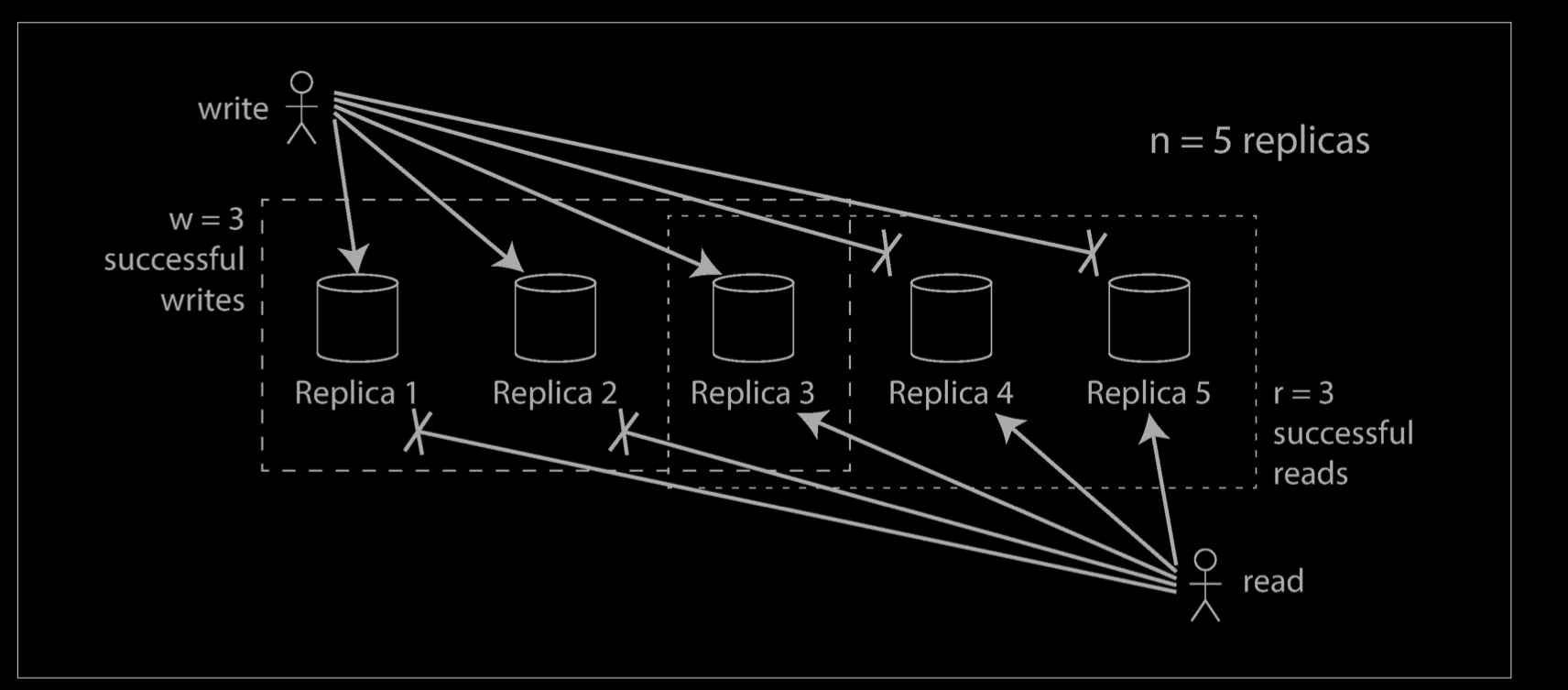
If fewer than the required w or r nodes are available, writes or reads return an error. A node could be unavailable for many reasons: because the node is down (crashed, powered down), due to an error executing the operation (can’t write because the disk is full), due to a network interruption between the client and the node, or for any number of other reasons. We only care whether the node returned a successful response and don’t need to distinguish between different kinds of fault.
Limitations of Quorum Consistency
Detecting Concurrent Writes
Dynamo-style databases allow several clients to concurrently write to the same key, which means that conflicts will occur even if strict quorums are used. The situation is similar to multi-leader replication, although in Dynamo-style databases conflicts can also arise during read repair or hinted handoff.
The problem is that events may arrive in a different order at different nodes, due to variable network delays and partial failures. For example, the diagram shows two clients, A and B, simultaneously writing to a key X in a three-node datastore:
- Node 1 receives the write from A, but never receives the write from B due to a transient outage.
- Node 2 first receives the write from A, then the write from B.
- Node 3 first receives the write from B, then the write from A.
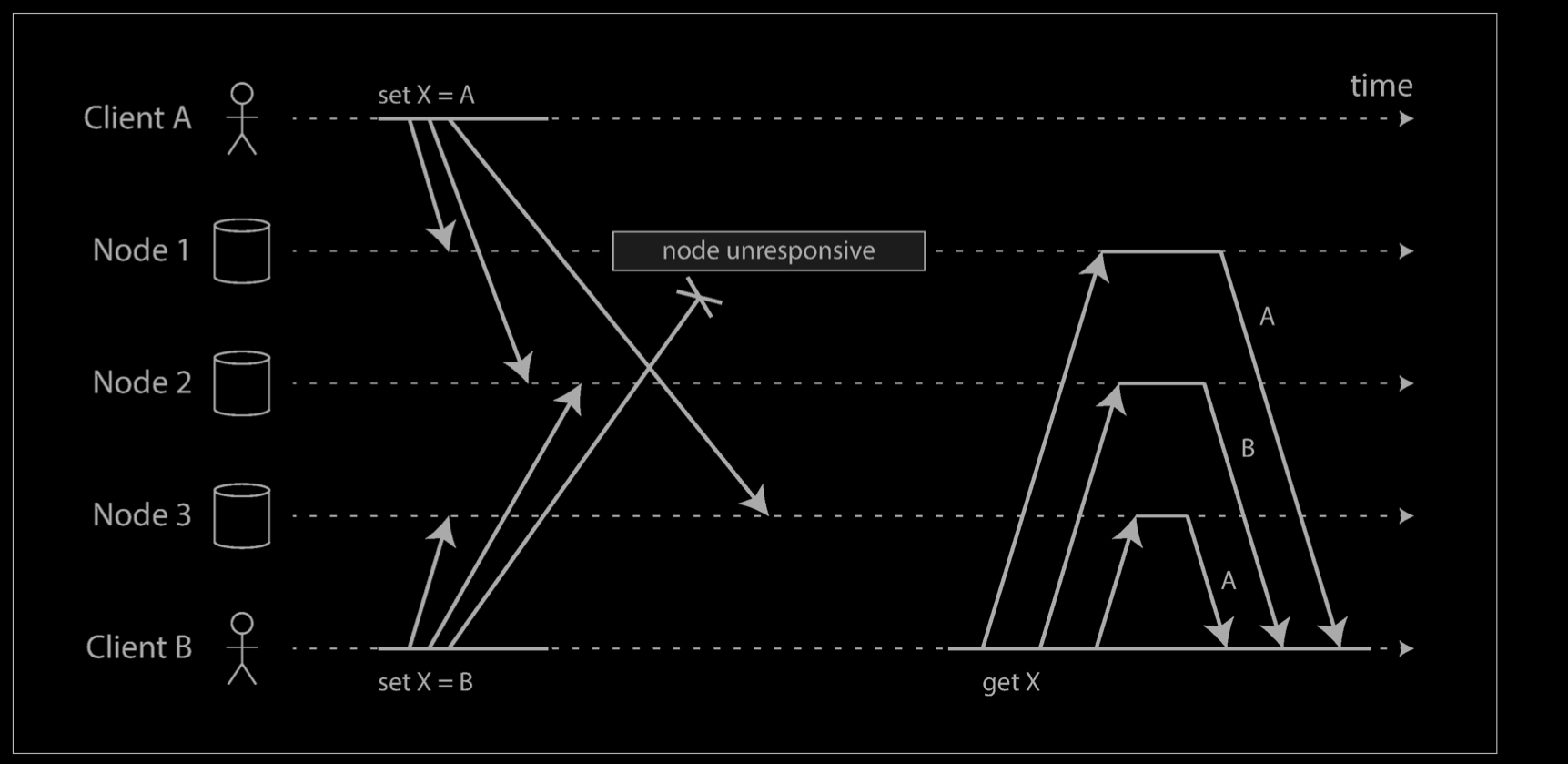
If each node simply overwrote the value for a key whenever it received a write request from a client, the nodes would become permanently inconsistent, as shown by the final get request as shown above: node 2 thinks that the final value of X is B, whereas the other nodes think that the value is A.
In order to become eventually consistent, the replicas should converge toward the same value. How do they do that? One might hope that replicated databases would handle this automatically, but unfortunately most implementations are quite poor: if you want to avoid losing data, you—the application developer—need to know a lot about the internals of your database’s conflict handling.
Last write wins (discarding concurrent writes)
One approach for achieving eventual convergence is to declare that each replica need only store the most “recent” value and allow “older” values to be overwritten and discarded. Then, as long as we have some way of unambiguously determining which write is more “recent,” and every write is eventually copied to every replica, the replicas will eventually converge to the same value.
As indicated by the quotes around “recent,” this idea is actually quite misleading. In the example above, neither client knew about the other one when it sent its write requests to the database nodes, so it’s not clear which one happened first. In fact, it doesn’t really make sense to say that either happened “first”: we say the writes are concurrent, so their order is undefined.
Even though the writes don’t have a natural ordering, we can force an arbitrary order on them. For example, we can attach a timestamp to each write, pick the biggest timestamp as the most “recent,” and discard any writes with an earlier timestamp. This conflict resolution algorithm, called last write wins (LWW), is the only supported conflict resolution method in Cassandra, and an optional feature in Riak.
LWW achieves the goal of eventual convergence, but at the cost of durability: if there are several concurrent writes to the same key, even if they were all reported as successful to the client (because they were written to w replicas), only one of the writes will survive and the others will be silently discarded. Moreover, LWW may even drop writes that are not concurrent.
There are some situations, such as caching, in which lost writes are perhaps acceptable. If losing data is not acceptable, LWW is a poor choice for conflict resolution.
The only safe way of using a database with LWW is to ensure that a key is only written once and thereafter treated as immutable, thus avoiding any concurrent updates to the same key. For example, a recommended way of using Cassandra is to use a UUID as the key, thus giving each write operation a unique key.
The “happens-before” relationship and concurrency
How do we decide whether two operations are concurrent or not? To develop an intuition, let’s look at some examples:
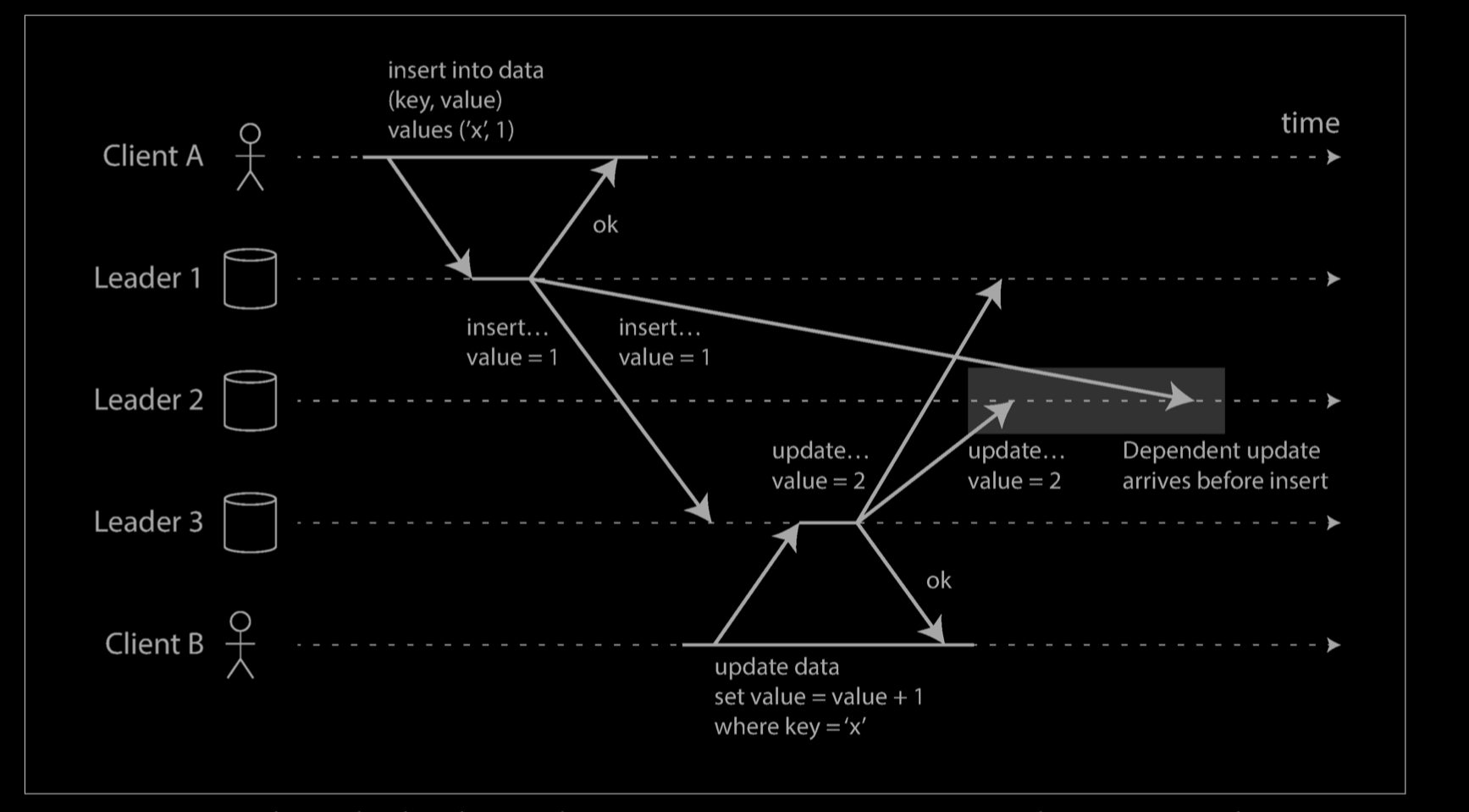
- In the example above, the two writes are not concurrent: A’s insert happens before B’s increment, because the value incremented by B is the value inserted by A. In other words, B’s operation builds upon A’s operation, so B’s operation must have happened later. We also say that B is causally dependent on A.
- On the other hand, the two writes in the example below are concurrent: when each client starts the operation, it does not know that another client is also performing an operation on the same key. Thus, there is no causal dependency between the operations.
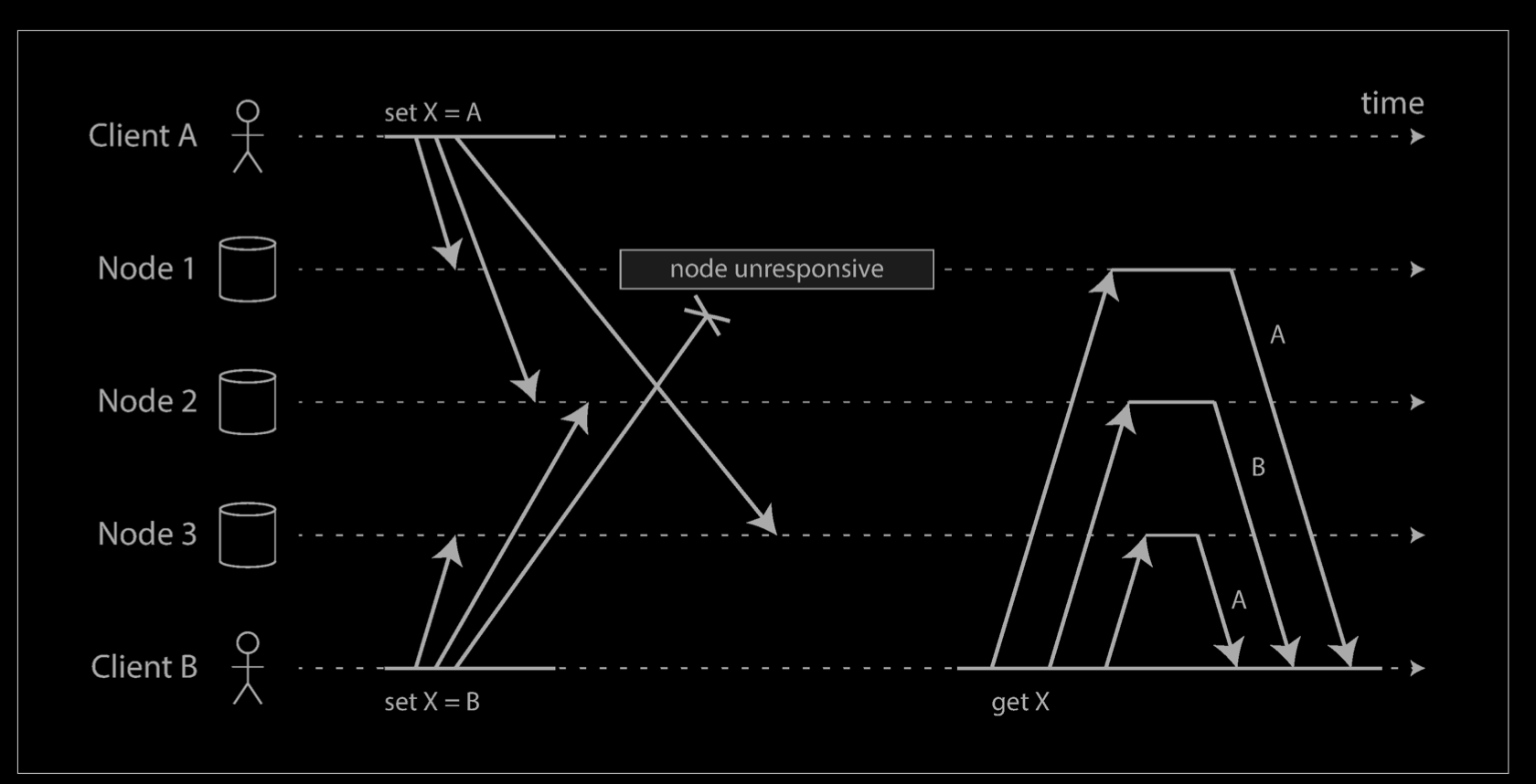
An operation A happens before another operation B if B knows about A, or depends on A, or builds upon A in some way. Whether one operation happens before another operation is the key to defining what concurrency means. In fact, we can simply say that two operations are concurrent if neither happens before the other (i.e., neither knows about the other) [54].
Thus, whenever you have two operations A and B, there are three possibilities: either A happened before B, or B happened before A, or A and B are concurrent. What we need is an algorithm to tell us whether two operations are concurrent or not. If one operation happened before another, the later operation should overwrite the earlier operation, but if the operations are concurrent, we have a conflict that needs to be resolved.
Capturing the happens-before relationship
Let’s look at an algorithm that determines whether two operations are concurrent, or whether one happened before another. To keep things simple, let’s start with a data‐base that has only one replica. Once we have worked out how to do this on a single replica, we can generalize the approach to a leaderless database with multiple replicas.
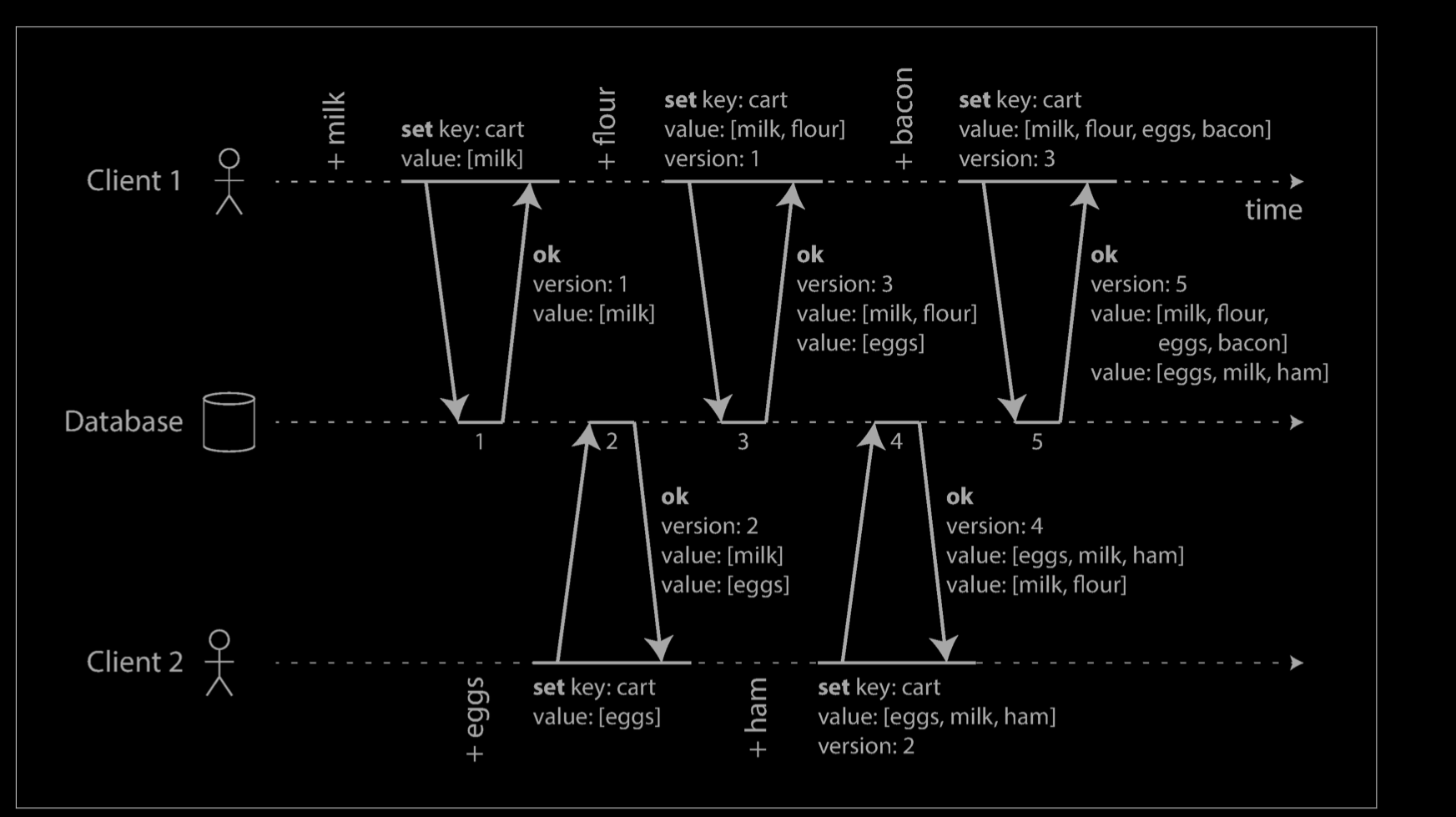
Merging concurrently written values
Version vectors
Reference
- https://en.wikipedia.org/wiki/Replication_(computing)
- Designing Data-Intensive Applications: The Big Ideas Behind Reliable, Scalable, and Maintainable Systems